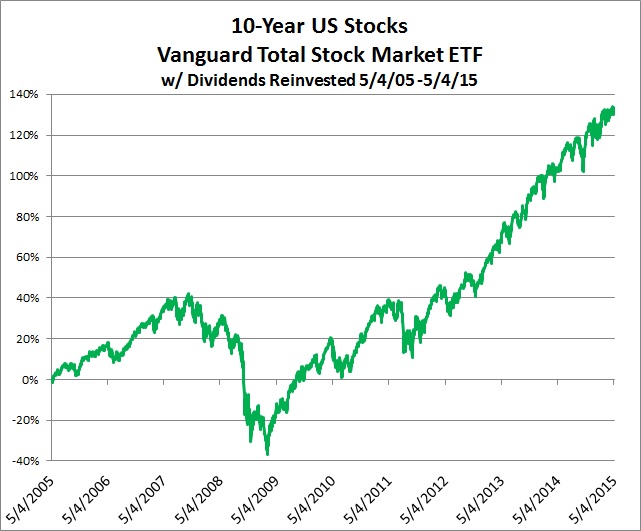AARP Hearing Center
Stock Investing: Time Versus Timing
By Allan Roth, May 11, 2015 03:40 PM
More and more investors are telling me that their portfolios have now fully recovered from the 2008 stock market crash. I respond in my typical tactless way by telling them their performance has been awful. That’s because stocks are now 64 percent above their pre-crash high.
Put another way, if you had timed the market perfectly wrong and put $10,000 in a total stock market index fund on Oct. 9, 2007, the pre-crash peak, you’d have about $16,375 today. All you had to do is let the dividends reinvest and have the courage to do nothing.

Get the latest tips on protecting your money and saving for retirement — AARP Money newsletter »
The chart above shows the performance of the Vanguard Total Stock Index Fund ETF ( VTI) over the past decade. The above equates to an 8.8 percent annual return over the past 10 years. Although a bit lower, the real shocking number is that the perfectly poorly timed return since Oct. 9, 2007, was a respectable 6.7 percent annually. Over that period, stocks outpaced inflation by about 51 percent. That means you could buy more than half again as many goods and services, at least before taxes.
More context
There is no doubt that the 2007 stock market was an extreme bubble. Lehman Brothers was a Wall Street behemoth and banks were lending to anyone with a pulse, believing that real estate could never decline in value. Hindsight shows we were in a period of irrational exuberance as stocks were about to lose more than half their value.
Only 18 months later, the great recession was in full swing and the term “cash is king” echoed in the land. Harry Dent’s book, The Great Depression Ahead (Free Press, 2009), was a best-seller. We were in a new paradigm as government bailouts and economic policy were in uncharted waters.
With some hindsight, both the optimism of 2007 and the pessimism of 2009 were overblown and hold key lessons for investing.
Lessons learned
No one knows the future of financial markets, but keep these lessons in mind if you are investing:
- Capitalism tends to work in the long run. The time period you invest over is far more important than timing your investments.
- Neither good nor bad times last forever.
- New paradigms are very dangerous and should be ignored.
Get discounts on insurance and banking services with your AARP Member Advantages. »
What worked better than staying in the stock market for the long run was a strategy of rebalancing a portfolio over the decade. For example, a portfolio of 60 percent stocks and 40 percent bonds meant one had to sell stocks in 2007 after they surged and buy in 2008 after the plunge. Everyone knows it’s better to buy stocks after a 50 percent off sale, but most investors actually do the opposite.
Chart: Wealth Logic Analysis - data from Yahoo Finance, featured image - Warchi/iStock
Also of Interest
- Brokered CDs: Worth Exploring for Good Rates
- 11 Items With Hidden Costs
- Get Involved: Learn How You Can Give Back
- Join AARP: savings, resources and news for your well-being
See the AARP home page for deals, savings tips, trivia and more.































































